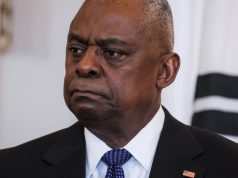
KABUL — Afghanistan’s defense minister and army chief of staff resigned on Monday after the deadliest Taliban attack on a military base, and US Defense Secretary Jim Mattis said he was “under no illusions” about the problems facing the country.
Mattis, visiting as the United States looks to craft a new Afghanistan strategy, held talks with Afghan President Ashraf Ghani, officials and US commanders, who want more troops.
“2017 is going to be another tough year for the valiant Afghan security forces and the international troops who have stood, and will continue to stand, shoulder to shoulder with Afghanistan against terrorism,” Mattis said.
General John Nicholson, the head of US and international forces in Afghanistan, said he was “not refuting” reports that Russia was providing support, including arms, to the Taliban.
A senior US military official, speaking on condition of anonymity, told reporters that intelligence showed Russia was providing money and machine guns to the Taliban.
Russia has previously denied providing any material or financial aid to the insurgent group, but has said it maintains ties with Taliban officials in order to push for peace talks. Moscow has been critical of the United States over its handling of the war in Afghanistan.
Mattis arrived in Kabul just days after a Taliban assault on a major army base in the northern city of Mazar-i-Sharif in which more than 140 Afghan soldiers were killed. Afghan officials said the final death toll was likely to be higher.
Earlier, Ghani’s office announced in a post on its Twitter account that Defense Minister Abdullah Habibi and Army Chief of Staff Qadam Shah Shahim “stepped down with immediate effect.”
Shah Hussain Murtazawi, acting spokesman for Ghani, told Reuters the resignations were because of Friday’s attack. Habibi and Shahim told reporters their resignations were voluntary.
Despite his resignation, Habibi — who had come under pressure from Afghan lawmakers last month following an Islamic State attack on a Kabul military hospital — attended a meeting with Mattis at the headquarters of the NATO-led military coalition in the Afghan capital.
Deadly attack
In a serious security failure on Friday, as many as 10 Taliban fighters, dressed in Afghan army uniforms and driving military vehicles, made their way on to the base and opened fire on soldiers and recruits eating a meal and leaving a mosque after Friday prayers, according to officials.
Ghani’s office also announced the replacement of four army corps commanders in response to the attack, and defense officials said as many as eight army personnel had been arrested.
A senior US official said, based on intelligence and the types of tactics used, the Taliban-linked Haqqani network likely played a role. “This is very typical Haqqani network tactics, techniques and procedures,” said the official, adding the United States believed it took 4-6 months to plan the attack.
Ghani declared a day of mourning on Sunday.
The attack came a little more than a week after the United States dropped a 22,000 pound bomb, known as the “mother of all bombs”, against a series of Islamic State caves and tunnels near the border with Pakistan.
US officials say they were surprised by the level of attention that particular bomb received, since it did little to change the situation on the ground, where the Taliban, not Islamic State, remains the bigger threat.
More troops
US officials acknowledge that Afghanistan has rarely in recent years been considered a priority by decision makers, who have instead been consumed by Syria, Iraq and, increasingly, North Korea.
But there are signs that the Trump administration is making progress in crafting a policy for Afghanistan. US President Donald Trump’s National Security Adviser H.R. McMaster visited Afghanistan earlier this month, the first senior official from the new administration to do so.
US officials, speaking on the condition of anonymity, said there was an ongoing inter-agency review to determine the goals and milestones for the United States in Afghanistan.
Meanwhile, the Afghan army is preparing for what is expected to be a year of hard fighting against Taliban militants, who now control or contest more than 40 percent of the country.
Nearly 9,000 US troops remain in Afghanistan, in addition to thousands of international coalition forces.
Nicholson recently told a Congressional hearing he needed several thousand more international troops in order to break a stalemate in the long war with Taliban insurgents.
US officials say Nicholson’s request was making its way through the chain of command. Conversations, however, according to current and former officials, were revolving around 3,000 to 5,000 additional troops.
One official said there was an emphasis on creating a strategy that was not tied to artificial deadlines. Former President Barack Obama had wanted to reduce the number of US troops in Afghanistan before he left office.
While Mattis is no stranger to Afghanistan — he served there and was also the head of US Central Command — there are questions about what a few thousand additional US troops can achieve.
“Let’s face it, no matter how many troops you may send to Afghanistan, it’s going to be very difficult to end the war. We had 100,000 troops fighting in Afghanistan during the height of the surge and we didn’t end the war,” said Michael Kugelman, a South Asia expert at the Woodrow Wilson Center.









